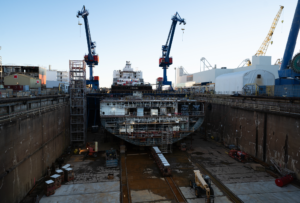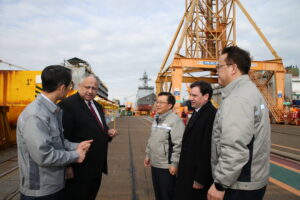South Korea’s Hanwha conglomerate agreed to purchase the Norwegian-owned Philly Shipyard
, the latter said on Thursday.
The transaction will involve Hanwha Group business segments Hanwha Systems and shipbuilder Hanwha Ocean entering into a share purchase agreement with Philly Shipyard. The company said the sale will be against a cash consideration of $100 million.

Philly Shipyards is currently owned by Norway’s Aker Group industrial investment company.
“After two decades of stewardship, it is with great honor that we transition the ownership from Aker to Hanwha. Recognized as a global leader, Hanwha brings a wealth of sophisticated shipbuilding experience that will enable Philly Shipyard to realize a grander vision for its employees and customers,” Kristian Røkke, chairman of Philly Shipyard ASA, said in a statement.
“Reflecting on the past 17 years, I am personally grateful for the opportunity to have worked side by side with the people of Philly Shipyard and eagerly anticipate witnessing the shipyard’s continued growth and success in the future,” he continued.
This transaction is subject to approval by the Committee of Foreign Investments in the U.S. and other regulatory approvals. Philly’s board of directors has approved the transaction after receiving a fairness opinion from the Norwegian Arctic Securities investment bank.
The shipyard said that, subject to satisfaction of all closing conditions, the parties expect this transaction will close during the fourth quarter of 2024.
The announcement also noted if cost overruns in excess of $100 million in current projects undertaken by the current owners compared to current estimates, the parties agreed to principles to reduce the payable purchase price at closing.
This acquisition follows efforts by Secretary of the Navy Carlos Del Toro to get foreign allied shipbuilders like Hanwha to invest in U.S. shipyards, in the hope of boosting investment and capabilities, ultimately adding more competitors for Navy programs.
In February, Del Toro visited both Hanwha Ocean and South Korea’s HD Hyundai Heavy Industries to lobby them to invest in dual-use commercial military shipyards in the U.S. (Defense Daily, March 1)
“As I saw firsthand during my shipyard visits in Korea this week, Hanwha and Hyundai set the global industry standard. I could not be more excited at the prospect of these companies bringing their expertise, their technology, and their cutting-edge best practices to American shores. As world class leaders in the global shipbuilding business, they are poised to energize the U.S. shipbuilding marketplace with fresh competition, renowned innovation and unrivaled industrial capacity,” he said at the time.

Then, in April, Del Toro expanded that he was impressed by South Korean shipyard digitization, real time monitoring and shipbuilding progress and saw investing in the U.S. as an opportunity for Korean firms to improve their position and improve U.S. commercial and military shipbuilding options (Defense Daily, April 10).
He noted that U.S. warship production is currently inefficient and at too slow a pace. In contrast, “our Korean and Japanese allies, for example, build high quality ships, including an Aegis destroyer, for a fraction of the cost we do.”
Philly Shipyards is located on part of the site of the former Philadelphia Naval Shipyard that closed in 1995 following the end of the Cold War.
The facility currently splits its work into production of commercial vessels like container ships and tanks to deliver about half of all oceangoing commercial Jones Act vessels; maintenance, repair, overhaul and conversion work for several Military Sealift Command ships; and building five National Security Multi-Mission Vessels (NSMV) for the Transportation Department’s Maritime Administration.
The NSMVs are being built for the National Defense Reserve Fleet to replace old training vessels for the six state maritime academies. The NSMVs will accommodate up to 600 cadets in ships about 525 feet long, 89 feet wide that can travel up to 18 knots.
Philly Shipyard’s website notes it has two dry docks typically divided into new hull builds and final outfitting, two heavy lift transporters that can lift up to 420 tons each, several cranes, over 430,000 square feet of fabrication ships, a grand block shop, a paint shop, outfitting warehouse under construction and cabin assembly line under construction.